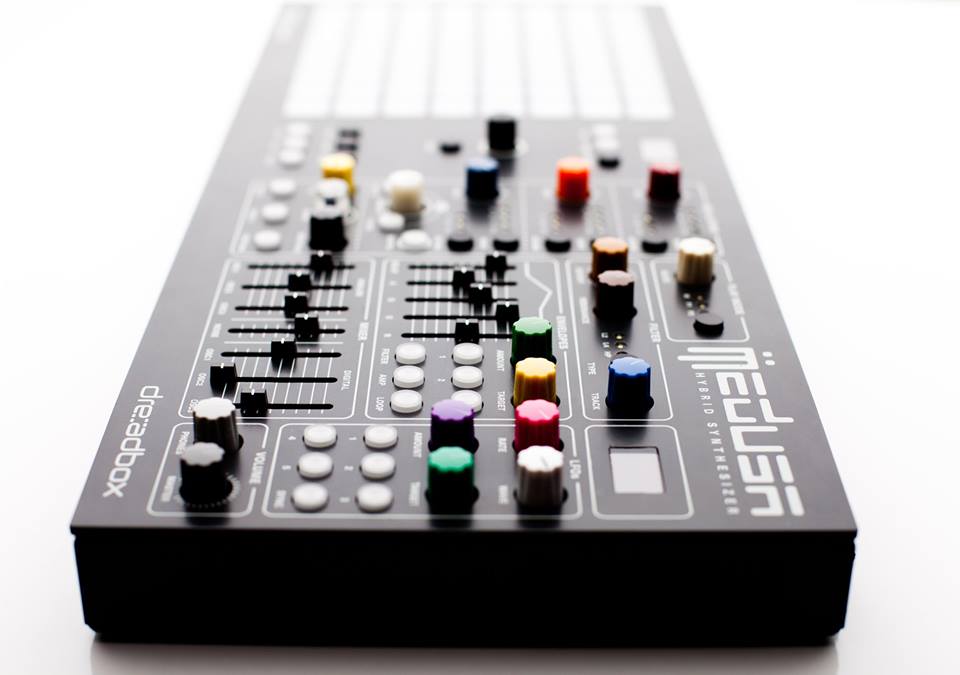With characteristic engineer’s modesty, Polish maker Polyend calls its Medusa wavetable+analog grid “slightly different.” But it’s really rather different, and a €798 price makes it more accessible.
TL
I’m honestly surprised, then, that it hasn’t gotten more attention, but I think it could be a slow burner. At the risk of being accused of shilling for Polyend, let me explain why I feel that way; you’re welcome to disagree, naturally.
Let’s get into it:
There’s an embarrassment of riches in the synth world now, both modular and desktop. And 2019 has quickly become a flood of instruments employing wavetable synthesis. At first, I thought that might make the more boutique, idiosyncratic Polyend Medusa lost in the crowd. But on reflection, I think now with all these wavetable options – and yes, more about those soon – the Medusa stands out.
I’ll be a bit blunt. One drawback of wavetable synthesis is that the sounds can become grating. And the same thing that makes wavetable appealing (wild possibilities as you modulate through the wavetables) can also make it tiring or hard to control (wild possibilities as you modulate through the wavetables). That’s arguably an objective assessment, even – the whole idea of the approach is, you get a bunch of harmonic and inharmonic content shifting quickly. We’re not accustomed to that in acoustic instruments or most natural sound. It’s exciting, but too much of it could then become like drinking hot sauce out of the bottle.

So with that in mind, Medusa’s split personality seems rather prescient. By pairing the three digital wavetable oscillators with three analog oscillators, the Dreadbox analog filter (to tame some of that harmonic content), and an analog noise generator, there’s ample opportunity to balance out the instrument’s edgier sounds with some warm body. And Polyend’s deceptively simple approach – putting dedicated fader smack dab in the middle of the unit – means you can literally just reach out and grab either side to adjust.
If you just want a wavetable synthesizer, in other words, you now have a growing number of cheaper options. But a big reason why I don’t want to part with the Medusa is, it has this strong tendency to be warm and fuzzy when you want it to be – and to mix hard-synced analog sounds with the wavetable ones.

That alone isn’t quite enough to set apart the Medusa, though, since there are various other architectures available. So now, some of the braver design decisions Jacek and Polyend made on the Medusa mean that it continues to stand out of the pack. That is, no one else is really attacking ideas like this:
- The XYZ touch detection of the Medusa grid (which is still astoundingly precise and expressive, something that’s hard to nail on this sort of 8×8 grid)
- MPE compatibility (now a MIDI standard for polyphonic expression, so you can use all those fingertips of yours independently, as intended)
- Lots of independent modulation sources and the ability to route them with just a couple of button presses – that is, the five LFOs and five loopable envelopes – all without menu diving.
Here’s a beautiful demonstration of how well this MPE stuff works, using Polyend’s also-superb Poly 2 MIDI to CV converter. It really makes an excellent polyphonic controller for modular hardware and advanced MPE-compatible software synths:
On specs alone, other wavetable instruments do look competitive. But none so far under a grand offers this accessibility of modulation and expression that the grid and control layout of the Medusa
And I feel now more than ever than owning the Medusa really is like having a unique Eurorack modular, minus the rack. And it’s one that you get attached to, rather than wanting to unscrew a couple of modules and put them up for sale used. (Yes, Dreadbox for their part even
All of this ought to be an answer to people droning on… Oh, wait – drones! I forgot! Drone mode is really superb, allowing you to latch tones and create gorgeous, shifting drones. You can spend hours doing this.
Sorry, got distracted there. Where was I? Oh yes –
People are constantly droning on (a much less appealing sound than music drones) about how there are no new ideas in electronic instruments, yadda yadda, everything is from the 70s, everything is a clone or remake…
The Medusa ought to be an answer to that, if more people paid it some attention. 3D grid sensing is absolutely new, as is the kind of integrated control possible here. Now, sure, individual elements like envelopes and wavetable synthesis and 24dB/octave analog filters are all new. But it’s peculiar that synths are suddenly held up to this idea of needing to reinvent fundamental building blocks every single time. If acoustic instruments were judged by the same standard, you could argue there was no difference between a bagpipe, an English horn, and a Cambodian Sralai because they all have reeds. The exact combination really does matter. You might love or hate the combination on the Medusa, but that’s the point – it feels like a particular set of instrumental decisions.
I’ve reviewed the Medusa already, though, and thanks to being slow with my review incorporated lots of the firmware improvements early reviewers missed.
But I do feel reasonably confident in saying it’s worth a look if €799 is now in budget. It’s definitely not for everyone. But why should everything be that? What the Medusa proves is, even doing something relatively obvious (polyphony, wavetable sound sources), you can still remain unique by taking some risks.
And if I didn’t cheer-lead a bit for that, it would mean I had probably ceased being myself.
Previously, full review: